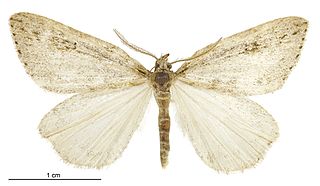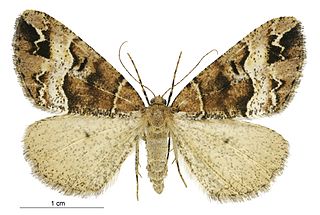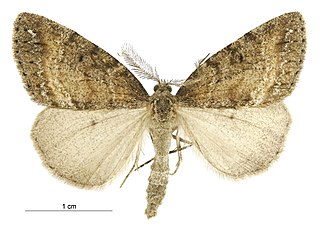
Pseudocoremia melinata is a moth of the family Geometridae. It is endemic to New Zealand.

Pseudocoremia indistincta is a species of moth in the family Geometridae. It is endemic to New Zealand.

Pseudocoremia cineracia is a species of moth in the family Geometridae. It is endemic to New Zealand. It is classified as Nationally Vulnerable by the Department of Conservation.

Helastia semisignata is a moth of the family Geometridae. This species is endemic to New Zealand and is only found in the North Island. The life history of this species is in need of further investigation as sources differ about what plants host the larvae. Adults are on the wing commonly from October until March.

Pseudocoremia amaculata is a species of moth in the family Geometridae. It is endemic to New Zealand and has been observed at St Arnaud. As at 2003 the female of this species is unknown. This species has been shown to be parasitised by species of wasps in the genera Aleiodes, Casinaria and Glyptapanteles.

Pseudocoremia campbelli is a species of moth in the family Geometridae. It is endemic to New Zealand.

Pseudocoremia colpogramma is a species of moth in the family Geometridae. This species was described by Edward Meyrick in 1936. It is endemic to New Zealand.

Pseudocoremia fascialata, also known as the Horopito flash, is a species of moth in the family Geometridae. It is endemic to New Zealand.

Pseudocoremia flava is a species of moth in the family Geometridae. It is endemic to New Zealand.

Pseudocoremia insignita, also referred to by the common name tree nettle flash, is a species of moth in the family Geometridae. It is endemic to New Zealand.

Pseudocoremia lactiflua is a species of moth in the family Geometridae. It is endemic to New Zealand.

Pseudocoremia lupinata is a species of moth in the family Geometridae. It is endemic to New Zealand and can be found in both the North and South Islands. The favoured habitat of this species is Kānuka scrubland as its larval hosts are species in the genus Kunzea. Both the larvae and adults of this species are nocturnal. Adult moths are commonly on the wing from December to June and are attracted to light.

Pseudocoremia modica is a species of moth in the family Geometridae. It is endemic to New Zealand.

Pseudocoremia monacha is a species of moth in the family Geometridae. It is endemic to New Zealand. Adults of this species pollinate Veronica salicifolia.

Pseudocoremia ombrodes is a species of moth in the family Geometridae. It is endemic to New Zealand.

Pseudocoremia pergrata is a species of moth in the family Geometridae. It is endemic to New Zealand. In 1988 J. S. Dugdale synonymised P. pergrata into this species, however in 2003 P. pergrata was reinstated as species separate from P. insignita.

Pseudocoremia productata is a species of moth in the family Geometridae. It is endemic to New Zealand.

Pseudocoremia terrena is a species of moth in the family Geometridae. It is endemic to New Zealand.

Pseudocoremia foxi is a species of moth in the family Geometridae. It is endemic to New Zealand.
Pseudocoremia hudsoni is a species of moth in the family Geometridae. It is endemic to New Zealand.



















